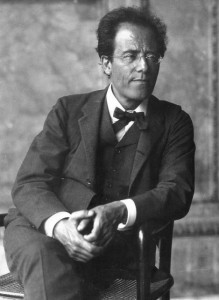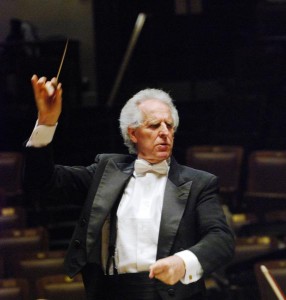Concert Review: Boston Philharmonic Orchestra/Benjamin Zander at Sanders Theater
In the slow third movement, Mr. Zander, the BPO, and the symphony seemed to really be in sync: the music breathed, sighed, sang, and unfolded at a natural pace that brought out the best in everybody.
Mahler’s Sixth Symphony. Performed by The Boston Philharmonic Orchestra. Conducted by Benjamin Zander. At Jordan Hall, Boston, MA, February 23 and at Sanders Theater, Cambridge, MA, February 24.
By Jonathan Blumhofer
“A symphony must be like the world,” Gustav Mahler famously told Jean Sibelius at their only meeting in 1907. “It must embrace everything.” Of the nine numbered symphonies Mahler finished, this statement was probably most fully realized in his Symphony no. 6, a grim, towering essay completed in 1904 that is the sole focus of the Boston Philharmonic Orchestra’s (BPO) third program of the current season. Led by music director Benjamin Zander, the BPO’s first outing of this piece on Thursday night at Sanders Theater took some time to settle, but, once it did, it revealed a score as timely as ever and a composer still with much to say to those willing to listen.
Though, structurally, it is the most Classical of Mahler’s symphonies, the Sixth’s musical content explores a program as vividly gory and cinematic as anything Berlioz or Liszt imagined. For the fourth movement finale, Mahler envisioned an autobiographical “hero. . .[brought down by] three hammer-blows of fate, the last of which fells him as a tree is felled.” The three earlier movements prepare this scene with various allusions, including a musical representation of Mahler’s wife, Alma; a depiction of Mahler’s toddling daughters at play; and references to nature (among many other things).
And, while it culminates in a fatalistic cataclysm, it’s not an entirely morbid journey: the Sixth contains some of the most transcendent music Mahler ever wrote. That this serene music brushes up against some of the ugliest music he ever composed is striking, but it only serves to make the musical drama all the more powerful.
In Thursday’s performance, the first two movements seemed to emphasize either the beautiful or the revolting in equal measure but without much exploring what might lie in between the two poles. Mr. Zander’s tempos in the opening movement felt remarkably deliberate, at times too much so. Though the orchestra maintained a satisfactory level of energy throughout and the slower pace lent a sense of inexorable doom to the proceedings, whole sections of the movement felt as though they were being held back against their will, and some of the music’s wilder moments—like the swirling string passages that cascade into the abyss—felt mannered and lacked their full measure of aggression.
The second movement Scherzo (Mr. Zander opted to follow Mahler’s later thoughts on programming the inner movements with the Scherzo followed by the Andante) began more promisingly (and briskly) but lapsed from time to time into insecurity, especially in the mixed-meter trios. Again, it felt like a matter of the music being held back: the vistas (and there are quite a few in both these movements) were treated as though they were nothing all that special, and the transitional sections between scherzos and trios were marked by occasionally timid playing and moments of ensemble disunity.
However, the slow third movement, after a somewhat breathless start, found a sure footing and blossomed into something very special. It’s easy to sometimes forget that Mahler was a master of the late Romantic lied and one of the nineteenth (and early twentieth) century’s greatest tunesmiths, but this movement reminds—and how. Here, Mr. Zander, the BPO, and the symphony seemed to really be in sync: the music breathed, sighed, sang, and unfolded at a natural pace that brought out the best in everybody, from the off-stage cowbells (actually in the balcony) to the sumptuous horn solos by principal Neil Deland. The music’s lyrical and dramatic qualities glowed throughout, no more so than in the final modulation from E major to E-flat, which came across as a purely magical transition.
And that spell carried into and through the finale. Clocking in at over 30 minutes, this last movement is arguably a symphony in itself, and one can’t blame Mr. Zander and the BPO for saving themselves a little bit for it. Thursday’s performance was captivating, even if there were a few patches where fatigue seemed to creep in.

It’s easy to forget that Mahler was one of the nineteenth (and early twentieth) century’s greatest tunesmiths.
But such flaws don’t necessarily detract from a construct of such Shakespearean intensity as this symphony; if anything, they add layers of meaning and humanity to it. Mr. Zander drew a finely paced account of this labyrinthine movement in which just about everything—from the spooky textures of its opening pages (surely the weirdest-sounding four minutes of music anybody’s yet written) to the soaring lyricism of its interior to the ferocious hammer blows that dot the procession of its program (realized on a specially-constructed, wood box struck with a lead plumber’s pipe)—felt inevitable. The heaven-storming climaxes were appropriately thunderous, but the expressive heart of this movement is also very much in its quieter sections, and these pastoral scenes were shaped with loving attention to detail and sensitive tonal coloring.
The score’s nihilistic conclusion makes the applause that inevitably follows particularly unsettling, though Thursday’s ovation was more than well deserved. Brass and percussion playing throughout the symphony was heroic and spot-on, marked by rhythmic precision and delicate shadings of tone; the winds shrieked and sang; and the string playing, led by concertmaster Joanna Kurkowicz’s several solos, energetically captured the many shifting characters of this most tragic of symphonies.
Thursday’s performance was part of the BPO’s Discovery Series, in which Mr. Zander prefaces the concert with an extended spoken introduction and musical examples. For this piece, which he clearly knows and loves, he proved an illuminating guide. If there were some opening night jitters (and there seemed to be a couple on Thursday), one anticipates that they’ll resolve themselves over the next two concerts (Saturday and Sunday at, respectively, Jordan Hall and Sanders). The second half of this program is already mesmeric; may it be so for the whole of it come the end of the weekend.
Jonathan Blumhofer is a composer and violist who has been active in the greater Boston area since 2004. His music has received numerous awards and been performed by various ensembles, including the American Composers Orchestra, Kiev Philharmonic, Camerata Chicago, Xanthos Ensemble, and Juventas New Music Group. Since receiving his doctorate from Boston University in 2010, Jon has taught at Clark University, Worcester Polytechnic Institute, and online for the University of Phoenix, in addition to writing music criticism for the Worcester Telegram & Gazette.

